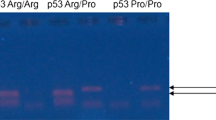Abstract
The potential association of distinct polymorphisms of the tumor suppressor gene p53 with an increased susceptibility to malignant transformation has been reported for various cancer entities. Most recently, p53 protein containing an arginine residue in codon 72 was shown to be more effectively degraded by the E6 oncoprotein of human papillomavirus (HPV) than the corresponding proline isoform in cervical carcinoma cells. Additionally, a seven times higher risk of cervical cancer for Arg homozygotes was suggested. We set out to confirm this allele-specific predisposition on a larger population, comprising 87 cervical cancer and 151 normal control samples. However, there was no significant difference in the observed frequencies of homozygous Arg genotypes in cervical cancer patients (52.8%) and normal controls (55.7%). Furthermore, the prevalence of the Arg/Arg allelotype did not vary between HPV+ (n=75) and HPV– (n=12) carcinoma samples. Thus, our investigation of a larger set of clinical samples does not support the proposed association of any polymorphic status of p53 at codon 72 with an elevated risk for cervical cancer.
Similar content being viewed by others
Author information
Authors and Affiliations
Additional information
Received: 23 October 1998 / Accepted: 10 November 1998
Rights and permissions
About this article
Cite this article
Klaes, R., Ridder, R., Schaefer, U. et al. No evidence of p53 allele-specific predisposition in human papillomavirus-associated cervical cancer. J Mol Med 77, 299–302 (1999). https://doi.org/10.1007/s001090050353
Issue Date:
DOI: https://doi.org/10.1007/s001090050353




